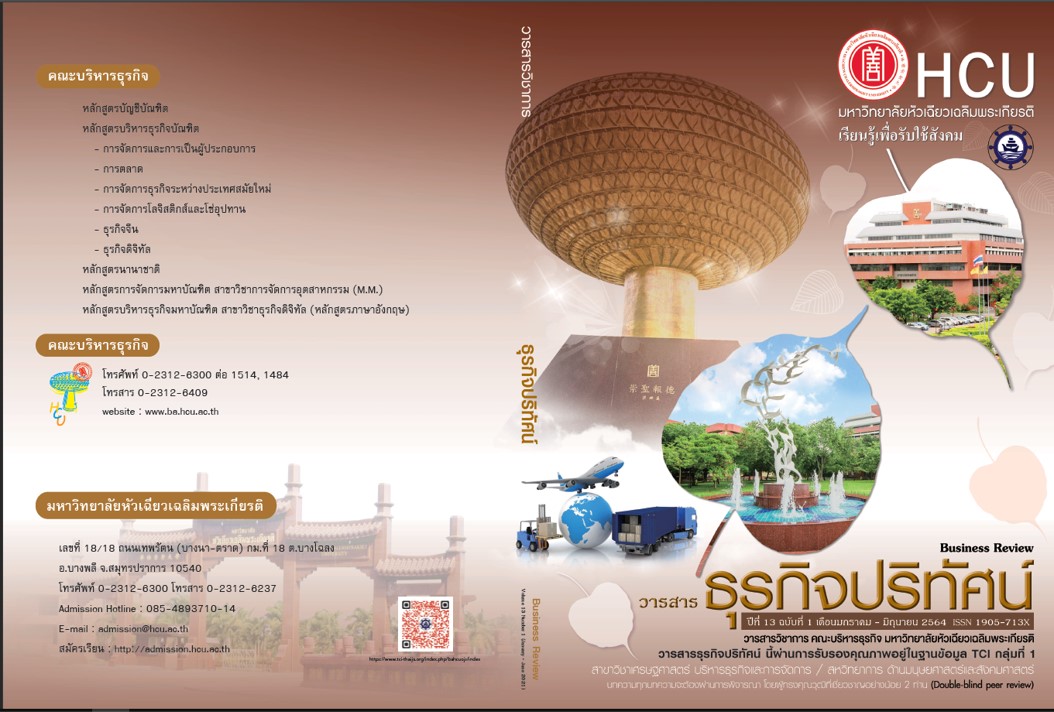Factors influencing Key Audit Matters Disclosure in Audit Reports of Companies Listed on Market Alternative for Investment (MAI)
Keywords:
Key audit matters, Audit reports, Market Alternative for Investment (MAI)Abstract
This research aims to examine the level of key audit matters (KAM) in the audit reports of companies listed in MAI during 2016-2018 and factors influencing key audit matters disclosure. The population and sample size of this study is 114 companies. Descriptive statistics, infer statistics and multiple regression have been analysed. The results show that there is an increasing trend of KAM disclosures, the average of KAM topic disclosure is 1.73 topics, and the average of KAM words disclosure is 643.89 words. Furthermore, researcher found there is a significant negative relationship between return on Asset and the KAM disclosures, whereas changing auditor during the study period, resource industry sector, and technology industry sector factors has a significant positive relationship with the KAM disclosures.
References
จิตติมา วิเชียรรักษ์, มัทนชัย สุทธิพันธุ์, กาญจนา รอดชุม, นันทิกานต์ ประสพสุข, วัลชนก ติ้งเพ็ง, และ เหมือนฝัน บุญสง. (2561). ความสัมพันธ์ของการเปิดเผยรายงานความรับผิดชอบต่อสังคมของกิจการกับค่าใช้จ่ายในการสอบบัญชีของบริษัทจดทะเบียนในตลาดหลักทรัพย์แห่งประเทศไทย. วารสารวิชาการ มหาวิทยาลัยหอการค้าไทย มนุษยศาสตร์และสังคมศาสตร์, 39(2), 68–82.
ชาญชัย ตั้งเรือนรัตน์. (2558). ประเด็นสําคัญและการประยุกต์แนวคิด เรื่องสําคัญในการตรวจสอบ. วารสารวิชาชีพบัญชี JAP, 11(32), 110-127.
ชาญชัย ตั้งเรือนรัตน์. (2560). การใช้รายงานของผู้สอบบัญชีแบบใหม่: ประสบการณ์ปีแรก. วารสารวิชาชีพบัญชี JAP, 13(38), 5-21.
ดารานาถ พรหมอินทร์ และกุสุมา ดำพิทักษ์. (2018). ความสัมพันธ์ของผลการดำเนินงานและคุณภาพกำไรต่อราคาตลาดหลักทรัพย์ของบริษัทจดทะเบียนในตลาดหลักทรัพย์แห่งประเทศไทย กลุ่มอุตสาหกรรมเทคโนโลยี. MBA-KKU Journal, 11(2), 37–59.
ตลาดหลักทรัพย์แห่งประเทศไทย. (2548). เกณฑ์การเปลี่ยนผู้สอบบัญชีของบริษัทจดทะเบียนทุก 5 รอบปีบัญชี. สืบค้นเมื่อ 29 มิถุนายน 2562, จาก ตลาดหลักทรัพย์แห่งประเทศไทย เว็บไซต์:https://www.sec.or.th/TH/Pages/News_Detail.aspx?SECID=1620
ตลาดหลักทรัพย์แห่งประเทศไทย. (2562). SET – maiข้อมูลบริษัทจดทะเบียน โครงสร้างการจัดกลุ่มอุตสาหกรรมในตลาดหลักทรัพย์ เอ็ม เอ ไอ (mai). สืบค้นเมื่อ 29 มิถุนายน 2562, จาก ตลาดหลักทรัพย์แห่งประเทศไทย เว็บไซต์:https://www.set.or.th/mai/th/company/industry_group_p1.html
ธกานต์ ชาติวงค์. (2560). ทฤษฎีที่ใช้อธิบายงานวิจัยทางบัญชี: จากอดีตถึงอนาคต. Journal of Business Administration The Association of Private Education Institutions of Thailand, 6(2), 203–212.
ธิดา อู่ทรัพย์เจริญชัย. (2548). ความสัมพันธ์ระหว่างคุณภาพกำไรกับรายงานของผู้สอบบัญชี. ปริญญานิพนธ์การศึกษามหาบัณฑิต, จุฬาลงกรณ์มหาวิทยาลัย.
มีสิทธิ์ แม่ดี. (2549). ความสัมพันธ์ระหว่างระยะเวลาการเป็นผู้สอบบัญชีของกิจการ ขนาดของสำนักงานสอบบัญชี และการเปลี่ยนผู้สอบบัญชีกับรายงานของผู้สอบบัญชีเกี่ยวกับปัญหาการดำเนินงานต่อเนื่อง ของบริษัทจดทะเบียนในตลาดหลักทรัพย์แห่งประเทศไทย. ปริญญานิพนธ์การศึกษามหาบัณฑิต, จุฬาลงกรณ์มหาวิทยาลัย.
ศิลปพร ศรีจั่นเพชร. (2560). “เรื่องสำคัญในการตรวจสอบ” ในหน้ารายงานผู้สอบบัญชีกับการตอบสนองของตลาดหลักทรัพย์แห่งประเทศไทย. วารสารวิชาชีพบัญชี JAP, 13(38), 22-37.
สภาวิชาชีพบัญชีในพระบรมราชูปถัมภ์. (2558). มาตรฐานการสอบบัญชี รหัส 705 (ปรับปรุง) เรื่องการแสดงความเห็นแบบที่เปลี่ยนแปลงไปในรายงานของผู้สอบบัญชีรับอนุญาต.สืบค้นเมื่อ 27 มิถุนายน 2562, จากสภาวิชาชีพบัญชีในพระบรมราชูปถัมภ์เว็บไซต์:http://www.tfac.or.th/upload/9414/4x9uV7CGE1.pdf
สภาวิชาชีพบัญชีในพระบรมราชูปถัมภ์. (2559a). มาตรฐานการสอบบัญชี รหัส 700 (ปรับปรุง) เรื่องการแสดงความเห็นและการรายงานต่องบการเงิน.สืบค้นเมื่อ 27 มิถุนายน 2562, จาก สภาวิชาชีพบัญชีในพระบรมราชูปถัมภ์เว็บไซต์:http://www.tfac.or.th/upload/9414/ttjvnkjJdF.pdf
สภาวิชาชีพบัญชีในพระบรมราชูปถัมภ์. (2559b). มาตรฐานการสอบบัญชี รหัส 701 เรื่องการสื่อสารเรื่องสำคัญในการตรวจสอบในรายงานของผู้สอบบัญชีรับอนุญาต. สืบค้นเมื่อ 27 มิถุนายน 2562,จากสภาวิชาชีพบัญชีในพระบรมราชูปถัมภ์เว็บไซต์:http://www.tfac.or.th/upload/9414/4x9uV7CGE1.pdf
สำนักงานคณะกรรมการกำกับหลักทรัพย์และตลาดหลักทรัพย์, 2560. การกำกับดูแลผู้สอบบัญชี. สืบค้นเมื่อ 30 มิถุนายน 2562, จาก สำนักงานคณะกรรมการกำกับหลักทรัพย์และตลาดหลักทรัพย์เว็บไซต์:https://www.sec.or.th/TH/Pages/LawandRegulations/AuditorDoc.aspx.
อัญญา ขันธวิทย์ และสุลักษมณ์ ภัทรธรรมมาศ. (2549). กลไกของตลาดการเงินในระบบเศรษฐกิจไทย. กรุงเทพฯ: อมรินทร์พริ้นติ้งแอนด์พับลิชชิ่ง จำกัด (มหาชน).
Ball, R., Jayaraman, S., &Shivakumar, L. (2012). Audited financial reporting and voluntary disclosure as complements: A test of the confirmation hypothesis. Journal of Accounting and Economics, 53(1–2), 136–166.
Boonyanet, W., &Promsen, W. (2018). Key Audit Matters: Just Little Informative Value to Investors in Emerging Markets? Chulalongkorn Business Review, 41(159), 153–183.
Brasel, K., Doxey, M. M., Grenier, J. H., &Reffett, A. (2016). Risk disclosure preceding negative outcomes: The effects of reporting critical audit matters on judgments of auditor liability. The Accounting Review, 91(5), 1345–1362.
Christofferson, E., &Grönberg, K. (2018). Informativeness of Key Audit Matter (KAM) Disclosures: An exploratory study of ISA 701 in Sweden. Master Thesis, University of Gothenburg, Sweden.
Demartini, C., & Trucco, S. (2016). Does intellectual capital disclosure matter for audit risk? Evidence from the UK and Italy. Sustainability, 8(9), 867.
García, C. B., García, J., Martín, M. M. L., &Salmerón, R. (2015). Collinearity: Revisiting the variance inflation factor in ridge regression. Journal of Applied Statistics, 42(3), 648–661.
Gimbar, C., Hansen, B., &Ozlanski, M. E. (2016). Early Evidence on the Effects of Critical Audit Matters on Auditor Liability. Current Issues in Auditing, 10(1), A24–A33.
Hogan, C. E., & Wilkins, M. S. (2008). Evidence on the audit risk model: Do auditors increase audit fees in the presence of internal control deficiencies? Contemporary Accounting Research, 25(1), 219–242.
Ishak, Z., &Abidin, S. (2018). The Impact of Enhanced Communication Requirement and other Determinants on Audit Fees.InF. Baharom, Y. Yusof, M. Ahmad, and R. Romli(Eds.), Proceeding of Knowledge Management International Conference (KMICe) 2018(pp. 223-228), 25-27 July 2018, Miri Sarawak.Malaysia: Universiti Utara Malaysia.
Maroun, W., & Solomon, J. (2014). Whistle-blowing by external auditors: Seeking legitimacy for the South African Audit Profession? Accounting Forum, 38(2), 111–121.
O’Dwyer, B. (2001). The legitimacy of accountants’ participation in social and ethical accounting, auditing and reporting. Business Ethics: A European Review, 10(1), 27–39.
Suchman, M. (1995). Managing legitimacy: Strategic andinstitutional approaches. Academy of ManagementReview,20(3), 57l–610.
Taylor, D., & Liu, J. (2008). Legitimacy and corporate governance determinants of executives’ remuneration disclosures. Corporate Governance: The International Journal of Business in Society, 8(1), 59–72.
Velte, P. (2018). Does gender diversity in the audit committee influence key audit matters’ readability in the audit report? UK evidence. Corporate Social Responsibility and Environmental Management, 25(5), 748–755.
Wichianrak, J. (2018). Longitudinal study of Thai listed companies’ environmental disclosures and current environmental shadow accounts. PhD. Thesis, RMIT University, Melbourne, Australia.
Downloads
Published
How to Cite
Issue
Section
License
All articles published in the Business Administration and Management Journal Review are copyrighted by the journal.
The views and opinions expressed in each article are solely those of the individual authors and do not represent those of Huachiew Chalermprakiet University or any other faculty members. Each author is fully responsible for the content of their own article. Any errors or issues found are the sole responsibility of the respective author.




